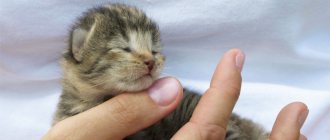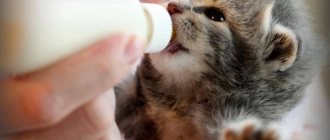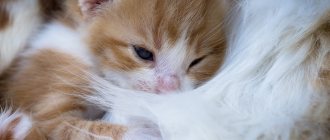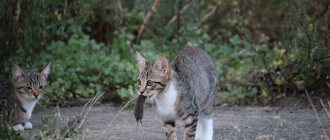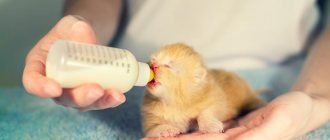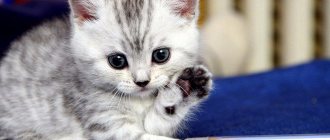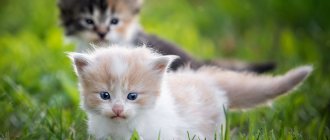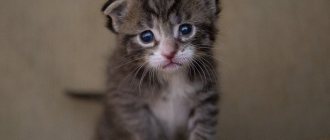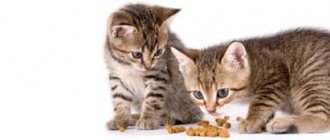Save the article:
feed a newborn kitten for various reasons. In any case, this is a serious responsibility for a small life.
The neonatal period for kittens ends at the age of two weeks. But these first two weeks of life play a decisive role not only in the future health of babies, but also for their very existence. During these two weeks, the kitten adapts to living outside the mother’s body, organs and systems continue to develop, breathing and circulatory processes normalize, the endocrine glands begin to work, changes in metabolism occur, and normal thermoregulation is established. And if during this period the owner is inattentive to the feeding procedure, then in addition to the development of diseases, this can lead to the death of the baby.
How often to feed a newborn kitten
The frequency of feeding kittens abandoned by a cat has long been determined by experts.
Until the fourth day of life, babies are fed every 2 hours around the clock. On the fifth day, the frequency changes: the baby can tolerate it for 3 hours. From the 14th day, only one night feeding is left, daytime feedings are left at the same interval. After 25 days of life, you need to feed 1 time at night; during the day, the interval between meals is 3-4 hours. From the 35th day, a gap of 4 hours is left during the day, and night feeding is removed.
If you have the fate of feeding a newborn kitten in the first days, then do not overfeed the cub: he is given 3-4 ml per feeding. With growth, the interval between meals and the single dose increase.
How to determine age, make a nest
The age of kittens is determined by several criteria:
- in the first three days a fresh umbilical cord is detected, later it falls off on its own;
- eyes open one and a half to two weeks after birth;
- the reaction to sounds appears from the fifth day, in addition, age can be calculated by the state of the ears - they are pressed to the surface of the head until the ear canal opens, then straightening occurs;
- by the third day of life, the baby weighs on average 100 g, after a week the weight gain is approximately 50 g, at the age of one month the baby’s body weight is 250 g;
- milk teeth appear in two-week-old kittens - the incisors grow first, then the fangs at the fourth week, all milk teeth appear by 4 months.
To create a cozy nest for kittens, you can use a small cardboard box. Since pets at an early age have a small body weight and an immature thermoregulation system, it is recommended to take care of heating.
For this purpose, use a heating pad and a cloth that is placed on the bottom of the box. Favorable temperature conditions range from 25 to 28-29 degrees.
Feeding Basics for Newborn Kittens
global $ads_google;
//data-ad-slot=”2475549904″ $ads_google = empty($ads_google) ? false : true; ?> if ($ads_google == false) {?> $ads_google = true; ?> } ?> If a cat does not feed newborn kittens , then the owner will have to become the mother.
To prevent the process from causing inconvenience, sit down comfortably and place a diaper on your knees. The cub is placed on the prepared bedding - it should lie as if it were being fed by a mother cat. If it is a newborn, then he is placed lying down and his head is raised slightly. It is important to ensure that your head is not thrown back excessively!
After placing the baby, they begin the feeding process itself.
Feeding methods
If you had to replace the furry mother, you need to know how to feed newborn kittens without a cat. First use a pipette or syringe. Although you can find specialized nipples and bottles in pet stores.
A drop of milk is squeezed out of the pipette and the crumbs are brought to the spout. As soon as the baby smells the milky aroma, he begins to look for the nipple. It is at this time that the new “mother” puts a syringe or pipette with milk mixture into his mouth. The main thing is not to swallow a lot of air, which can lead to abdominal pain.
Feeding diet for a newborn kitten
If feeding the kitten falls entirely on the shoulders of a person, then you need to take into account the laboriousness of the process and regularly allocate time for this. If there is no nurse cat nearby who would agree to take other people’s babies under her wing, then you need to think about the most suitable replacement for cat’s mother’s milk.
Together with mother's milk, kittens receive immunity, minerals and vitamins. A suitable mixture can be a replacement. You can buy it at a pet store or prepare it yourself. It is not advisable to heat the mixture in the microwave; it is better to heat it in a water bath until warm. Before giving the cat something to eat, they try to leave a drop of milk on their wrist so that the cub doesn’t get burned. In the first two weeks, the food temperature should correspond to the baby’s body temperature.
At the end of the newborn period, complementary foods consisting of formula and milk porridge begin to be introduced. Starting from day 21, it is useful to diversify the menu with low-fat cottage cheese, baby meat food, egg yolk, fish and lean beef. Starting from day 35, kittens are quite capable of eating from a bowl.
Kittens weight gain
A kitten's weight gain is an important indicator of its health, growth and development. On average, a kitten should gain 10 g per day; kittens of large breeds (Maine Coon, Norwegian cat and others) can gain 15 g per day.
The kitten should be weighed every day until the age of 2 weeks, from 2 to 4 weeks - once every 3 days, then you can switch to weekly weighing until the end of the kitten's growth period. The weight of a kitten, as well as the rate at which it gains, depends on the expected weight of an adult animal, which is determined by its gender or breed.
Table: kitten body weight depending on its age
| Kitten age | Body mass |
| at birth | 60–160 g |
| 1 Week | 110–260 g |
| 2 weeks | 140–360 g |
| 3 weeks | 200–600 g |
| 4 weeks | 240–750 g |
| 2 months | 400–1700 g |
| 3 months | 1.0–2.5 kg |
| 4 months | 1.7–3.9 kg |
| 5 months | 2.2–5.5 kg |
| 6 months | 2.3–6.0 kg |
| 7 months | 2.4–6.5 kg |
| 8 months | 2.5–6.9 kg |
| 9 months | 2.5–7.0 kg |
| 10 months | 2.5–7.7 kg |
| 11 months | 2.5–8 kg |
| 12 months | 2.5–9 kg |
| Adult animal | 2.5–10 kg |
Preparing a kitten feeding kit
To feed a kitten without a cat, you need to prepare everything you need, so that later it doesn’t turn out that something necessary is missing at that very moment.
First of all, you need to purchase auxiliary devices. You will need:
- plastic pipette;
- disposable syringe with a volume of 20 ml;
- catheter;
- pacifier;
- a small bottle with a narrowed spout (for children or intended for drinking kittens);
- measuring spoon;
- convenient bowl.
It is better to take several different pipettes and nipples at once, as some may not be suitable due to poor quality or may not withstand frequent washing. Syringes should also always be in stock.
If financial resources allow, you can simply purchase a ready-made kit for feeding animals: it includes a plastic bottle with a volume of 35 or 55 ml and a silicone nipple of a suitable size for one-week and two-week-old kittens.
Dairy products at 1 month
If there is a need to feed a 1-month-old kitten without a cat, then at first he simply needs milk or a milk formula that replaces it. To feed a baby who is 1 month old, you can use boiled cow's milk with the addition of a spoonful of honey per 1 glass of milk. This combination of foods in feeding has a pronounced taste and is very useful, especially for a growing organism.
You can also start feeding a kitten a month with low-fat cream, goat's milk and various fermented milk products, such as yogurt, sour cream, kefir, fermented baked milk, yogurt. He will love this food even as an adult.
© shutterstock
Feeding with ready-made formulas
global $ads_google;
//data-ad-slot=”2475549904″ $ads_google = empty($ads_google) ? false : true; ?> if ($ads_google == false) {?> $ads_google = true; ?> } ?> If you need to feed a kitten from its very birth, then you need to know what such babies are fed. Many people wonder whether it is possible to feed newborn kittens with infant formula or whether they will have to buy only specialized ready-made formulas.
If the situation is extreme, and there is baby formula in the house, then it can be diluted in a 1:2 ratio with water. Baby food formulas for the digestive system of kittens are too fatty and rich in micro- and macroelements. Diluted with water in the right proportion, they become less concentrated and heavy for the kitten’s stomach.
Cat milk substitutes have long been developed and sold in veterinary pharmacies. The milk of other animals is less suitable and can easily upset the animal's stomach.
Feeding formulas can be purchased in both liquid and powder form. The digestion of cat babies functions normally, the intestinal microflora is in perfect order.
Introduction of complementary foods
It is recommended to start introducing natural food when the kitten reaches 2 weeks of age. The following will work great for these purposes:
- meat pates;
- porridges cooked with milk and broth;
- egg white;
- cottage cheese;
- kefir and fermented baked milk;
- meat and vegetable mixtures.
If you want to transfer the kitten to a commercial diet, ready-made food at the age of 2-3 weeks, he is allowed to offer pates, jellies, mousses - semi-moist and wet food. It is recommended to soak dry food for kittens in water or milk for a while so that it acquires a softer consistency, similar to oatmeal.
What natural foods can you feed kittens?
But there are situations in which you have to take care of a newborn kitten yourself. And this is not an easy task. The most difficult thing is to properly feed a kitten . The slightest inattention to the quality of food and the feeding process can lead to poor health, the development of serious diseases and even the death of the pet.
If we are talking about a kitten up to two weeks old, then from natural products rice water, goat milk and condensed milk without sugar are suitable. The first portion should be very small in order to monitor the body's reaction to the new product.
You can also add corn oil, raw egg, and bone meal to the mixture.
If the baby has grown up and the question arises of how to feed a month-old kitten, then the situation here is simpler: cottage cheese, boiled chicken yolk, porridge with meat or milk broth and boiled vegetables are happily kneaded.
Cooking Recipes
Several proven recipes for kittens during the neonatal period:
Recipe No. 1
For 5 parts of 20% condensed milk take 1 part water, 1 tsp. bone meal and 1 liter of milk. All ingredients are mixed until smooth, the liquid is filtered and cooled to 36-38°C.
Recipe No. 2
For a glass of milk take 2 yolks, 1 tsp. vegetable oil, optionally a drop of vitamins.
Recipe No. 3
Food for weakly healthy kittens.
Half a glass of full-fat milk, yolk, 20 ml of glucose 5%, a drop of vitamins.
Strain the mixture and sell within 24 hours. Store the composition in the refrigerator and warm up to 37 °C before use.
Recipe No. 4
All components are taken per 1 kg of kitten weight, you will have to calculate everything correctly.
You need to take 50 g of full-fat milk, 15 g of whole milk powder, 3 g of dry yeast, 1 egg, 50 g of whipped protein, 1 g of vegetable oil, 4 g of glucose. The composition is mixed and heated to 37-38°C
Recipe No. 5
You will need 25 g of cow's milk, 5 g of whole milk powder, 2 g of glucose, 1 g of vitamin supplements.
Recipe No. 6
You need to take a teaspoon each of bone meal and milk, 5 tsp. 20% condensed milk and mix everything.
Recipe No. 7
To 50 g of whole milk powder add the same amount of boiled milk, half a raw yolk and 1 tsp. corn oil.
Recipe No. 8
Take 100 g of milk, yolk, 0.5 tsp. vegetable oil, 20 ml of 5% glucose, a drop of vitamins.
Natural nutrition
Natural feeding implies a diet consisting of natural products. Contrary to popular belief, pets should not be fed from the owner's table; such feeding can lead to the development of diseases.
When choosing a natural diet, veterinarians advise consulting with them in order to correctly calculate the menu for your pet. Excess or deficiency of substances can lead to disruption of growth and development processes, and junk food provokes the formation of diseases.
Features of the natural diet of kittens
For a carnivorous predator, sufficient protein intake is important, so the basis of the diet is meat. Veterinarians recommend feeding chicken, turkey or beef, as these varieties contain the least amount of fat.
Weak meat broths are given to babies from the second week. Soft minced meat is gradually introduced, and from a month on you can feed your pet finely chopped fillet.
For proper osteosynthesis, that is, the development of the bone apparatus, as well as the formation of teeth, a sufficient amount of calcium, magnesium and other elements that are contained in dairy products is necessary. The kitten's diet includes fermented baked milk, cow's milk, and cottage cheese.
Vitamins are found in fresh vegetables and fruits. At an early age they are served as a puree. By one month, the kitten can eat finely chopped ingredients.
The source of phosphorus is fish. Preference is given to marine species. In this case, the product is boiled and cleaned of bones. It is more advisable to use fillet.
Advantages
Supporters of natural nutrition explain their choice by the fact that natural nutrition does not contain harmful compounds - preservatives, additives, dyes, flavor enhancers. In addition, a wide variety of foods has a beneficial effect on your pet's health. With a properly designed menu, natural feeding ensures a complete supply of all necessary nutrients.
Flaws
Feeding your pet natural food can lead to poisoning if a prohibited product gets into the diet. In addition, independently compiling a menu may not take into account the individual needs of the baby and lead to a deficiency of vitamins and minerals or, conversely, their excess.
What should you not feed newborn kittens?
If you listen to the advice of experts, ignoring common sense, then it won’t take long for things to get into trouble. There are several “don’ts” in feeding newborn kittens, in addition to a strict feeding schedule, dosage and food intake rules.
- Cow's milk is not used in its pure form, as this can lead to severe indigestion and possible death.
- No cream, even diluted with water.
- Don’t rush and shove sausage or minced meat into your baby’s mouth.
- When the baby gets a little older, you also shouldn’t rush to feed him raw freshwater fish, otherwise he may be attacked by helminths.
Vitamins and supplements
Milk (cow's, goat's) and eggs are balanced products and can serve as food for a kitten. The content of essential amino acids and vitamins can support the body for up to 15-20 days without external vitamin preparations.
Next, you need to start complementary feeding. A signal for this could be:
- animal anxiety;
- search for food;
- greedily eating the norm of formula milk.
As a rule, this is observed from 2 weeks of age. During this period, it is necessary to enter into the daily menu:
- fish (sea);
- poultry meat;
- rabbit meat;
- veal;
- cottage cheese;
- curdled milk;
- kefir.
For complementary feeding, 3-5 g of minced meat per day is enough. Meat and fish should be boiled and ground together with the broth using a hand blender. If there is no broth, you can bring it to a soft consistency with milk or water.
No more than 2 new products are introduced into the diet every day.
Without knowing the taste, the kitten may not take the food itself. To accustom it, I put a small part into the kitten’s mouth and observe its taste preferences.
